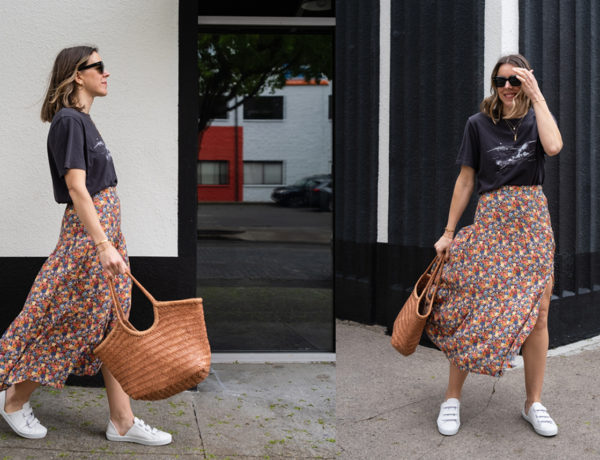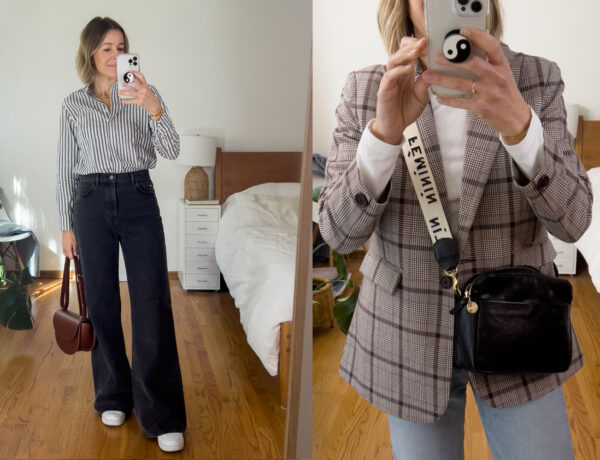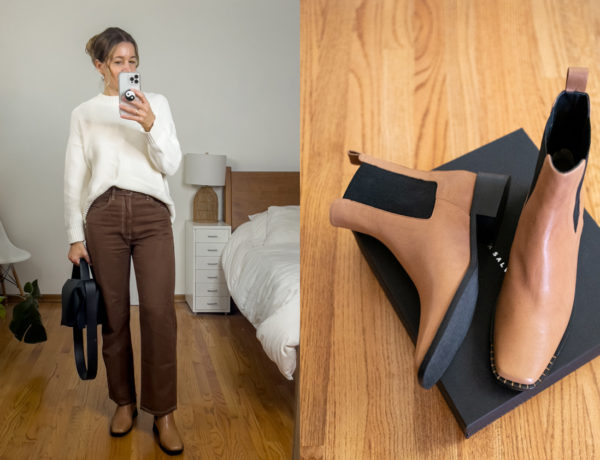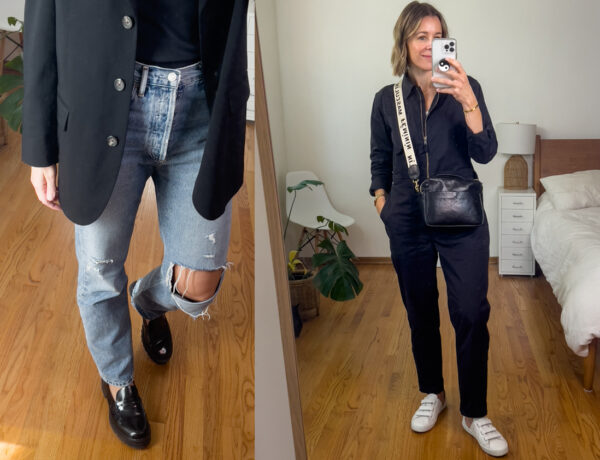
You might want to consider it ‘Weather Week’ here at Seasons + Salt. I did a brief rundown of my fall/winter coat situation a few days ago, sharing how I keep warm and dry on these wet, wintery days. While we’re at it, I thought I’d share my best tips for how to ‘winterize’ your leather shoes. I am not a big clothes hoarder, but I definitely tend to be a bit of a shoe hoarder. And there are fewer things more disappointing than sinking $$$ into shoes, then feeling like you can’t wear them all winter. Over the last few years I’ve cultivated a few methods to help protect my leather shoes from the elements, and they are helping me get the most out of my shoes.
Always watch the soles.
Naturally, this is the hardest-worn part of the shoe because it bears the brunt of our weight and comes into the most contact with the elements. If you stay on top of the condition of your soles, you can often make your shoes last a very long time. I first learned the importance of this back when I was a high schooler wearing Birkenstocks everywhere. The shoe repairman told me if I let my heels get too worn down, I’d damage the shoe and need bigger repairs. But if I stayed on top of things and replaced a small wedge on the heel before it down to the nubs, I could avoid that. The same principal can be applied to many of the other shoes in my closet. Keeping the heel in good condition helps avoid water damage and further breakdown of the shoe. Even the rubber pieces on the heels of clogs should be watched.
Many of my favorite shoes I’ve worn over the years, including Frye’s and Nisolo’s, are manufactured with leather soles. They are beautiful, sustainable, fully repairable, and even good for our feet. However, extensive wetness on leather soles can break them down much sooner than you want. The best way to prevent this is to add thin Toppy or Vibram soles to the bottoms of your shoes. Most cobblers can do this for around $30. It’s sleek, barely noticeable, yet highly effective. See photo below.
Mind the leather/suede/nubuck.
After I know my soles are tended to, the next thing I do to arm my shoes for winter is treat the leather. I use three main products to do this: Aussie Leather Conditioner for smooth leather, Kiwi Rain & Stain Protector for suede and nubuck, and Scotchgard Clear Shoe Guard for leather heels.
I typically condition the leather on all my brown shoes, to prevent water spots. Occasionally I’ll touch up my black leather shoes if the leather looks dry. Aussie Leather Conditioner is a beeswax-based leather conditioner, that strengthens and waterproofs. I love this stuff. I started using it awhile back after ABLE recommended it for use on their leather bags. (I’ve since treated at least three of my leather bags with this stuff.) It does make the leather look slightly darker at first, but most of the time it absorbs into the leather and it doesn’t look much different. It depends mostly on the grain of leather you are using. The thinner grain leathers seem more susceptible to darkening than the full-grain, thick leathers.
For my nubuck and suede boots, rain can definitely be the enemy, but if I only wore rainboots when it rained, I’d live in rubber boots all winter. No thanks! When I got my suede Boss Boots from Everlane I sprayed them twice with Kiwi Rain & Stain Protector before I wore them out of the house. I have had really good results with this spray, but the dual coats dulled my black suede boots a touch. From now on, I plan to only single-spray boots when they are brand new, and then apply a new coating at the start of the wet season. I am happy to report I just recently sprayed down a pair of nude, nubuck shoes, and the spray dried perfectly invisible. Side note: I recently learned that nubuck is thicker and more durable than suede, which is produced by splitting leather. If you ever have the choice between the too, opt for nubuck, which is buffed, full grain leather. Brands like Bryr and Nisolo use nubuck leathers in the production of their shoes.
The last step I do is try my best to seal the edges of the leather soles. I am not sure if this really works, but I figure it can’t hurt. Scotchgard’s Clear Shoe Guard has a spongey applicator tip that I run over the sides of the heels and soles of my shoes. My hope is that it’s one more barrier to keep the moisture out of the leather. I also hope it helps protect the heels on my right shoes, which usually show more signs of wear from driving.

Rest & reality.
Another way to get the most out of your shoes is to allow them to rest. Rotate them every day or so to let them recover. It’s important to allow shoes to dry out completely before wearing them again or you can permanently stretch them out (in ways you don’t want to).
Depsite my best efforts to keep my leather shoes waterproofed, there simply are some days where I can’t escape the need for rubber boots. I try to be smart and avoid my nubuck boots on ultra wet days. If it’s pouring buckets, I opt for my second-hand rain boots. (Alice + Whittles provides a beautiful, responsibly made option.) If I had to go to an office, or somewhere else with a final destination, I might consider popping my nice shoes in a tote, and wearing rainboots or snowboots while en route.
The best way to get the most out of our closets is to show love to what we already have. Preventative maintenance is a great way to do that. If you have any tips, do share how you keep your leather shoes looking their best.
[ Boots pictured above L-R: Felix Boot, Loeffler Randall, discontinued | Boss Boot, c/o Everlane | Isa Boot, c/o Nisolo | James Oxford, Nisolo ]
This post is not sponsored, but it does contain affiliate links. This means if you click through and make a purchase, I will make a small commission. Thank you for supporting Seasons + Salt!





I’m learning this lesson this week – I’ve never done much of anything to care for my shoes (save for spraying my UGG boots with protective spray in college, haha). Last week I realized that the sole of the heel of my favorite riding boots had gone missing! I finally took them into a shoe repair shop yesterday to be resoled and the shop will be cleaning up the scuffed up leather for me as well. My light grey suede boots are a mess despite some half-hearted attempts at cleaning and preventive sprays. This post is super helpful!
Glad this is helpful! I think even despite our best efforts, our shoes will take a beating in the PNW. Did you go to the Shoe Stop? That’s where I always take my shoes!
Thanks for sharing your nubuck pick! I just ordered my first pair of nubuck boots, and while they are already supposed to be waterproof, I’m sure I’ll need to touch them up at some point. Glad to have some direction when the time comes.
I’ve had the heels on my chelsea boots replaced several times (most recently after arriving at the Montreal airport; the cobbler I found there was the best I’ve ever used!), which has helped with traction and stability as well.
Yes! Traction is something I didn’t mention, but it is a huge benefit of caring for the soles. Nobody wants to slip in the wet weather. Leather soles can be slippery when wet. I get such a good feeling when I care for and renew my shoes and get to wear them longer.
Thank you for this advice. I’ll save and use as a reference because I’ve had some issues with some boots getting rained on it’s so frustrating! Luckily, I was able to fix them, but they were out of commission a couple of seasons.
Thanks for sharing your wisdom! I live in a typically snowy area and last year my leather boots took a beating despite me wiping them off after every use – so this winter I’ve made a goal to take better care of my leather boots. I love your perspective because you deal with wet conditions all the time too! P.S. I love when you share behind the scenes stuff like this! It’s so helpful. Hope you and your family are enjoying the holidays!